Labour Force
- Home
- Statistics
- Labour Market
- Labour Market Information
- Labour Force
Principal Statistics of Labour Force, Malaysia, Fourth Quarter (Q4) 2020
Key Statistics of Labour Force in Malaysia, November 2020 11 December 2020
Key Statistics of Labour Force in Malaysia, October 2020 9 November 2020
Key Statistics of Labour Force in Malaysia, September 2020 9 November 2020
Principal Statistics of Labour Force, Malaysia, Third Quarter (Q3) 2020 13 October 2020
Key Statistics of Labour Force in Malaysia, August 2020 11 September 2020
Key Statistics of Labour Force in Malaysia, July 2020 Show all release archives
Overview
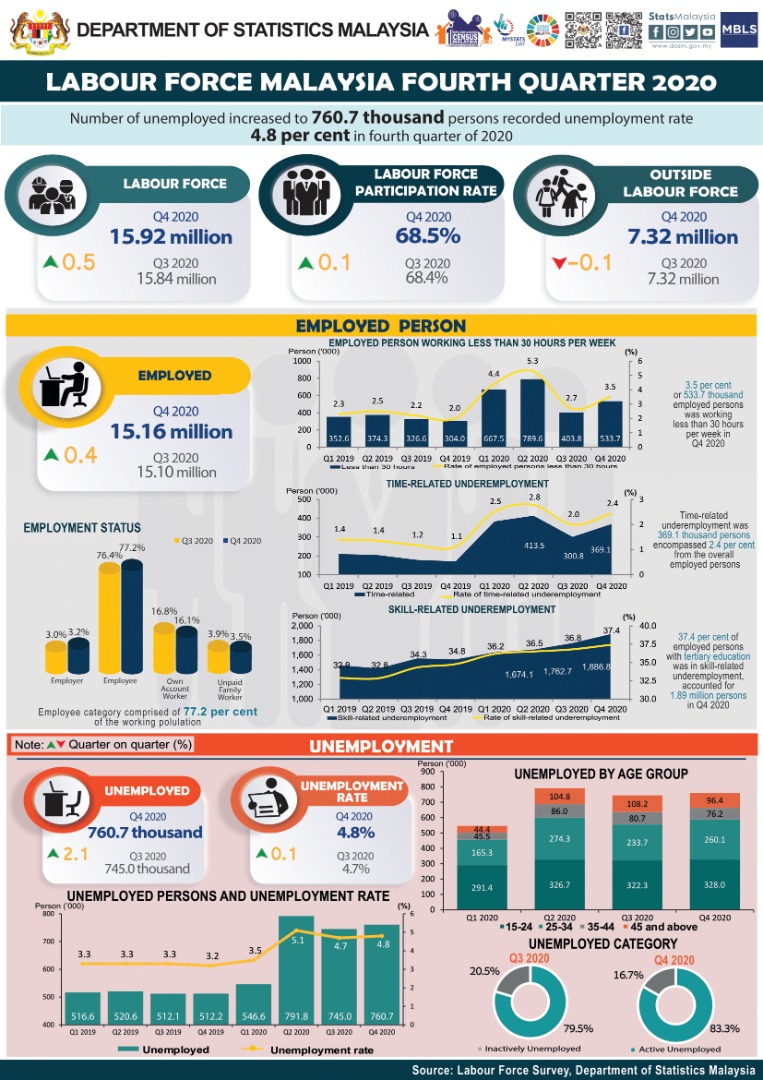
INTRODUCTION
In the fourth and last quarter of 2020, the COVID-19 pandemic heightened, resulting in the implementation of the Conditional Movement Control Order (CMCO) in phases. The CMCO started with Wilayah Persekutuan Kuala Lumpur, Putrajaya and Selangor in October 2020. Later, the CMCO extended to all states until the end of the year, although travel restrictions were relaxed in December 2020. Nevertheless, with the growing number of cases of COVID-19 in this quarter, the labour market was also affected.
The Labour Force Report for Fourth Quarter 2020 presents statistics of labour force based on the Labour Force Survey (LFS) for the fourth quarter of 2020. The survey is carried out using probability sampling through household approach comprising of Malaysian citizens and noncitizens to obtain data on the structure of labour force, employment and unemployment. The principal statistics are presented according to selected demographic and socioeconomic characteristics such as sex, age group, educational attainment, status of employment and occupation.
LABOUR FORCE
The labour supply situation improved gradually in quarter four of 2020 with the labour force continued to increase 0.5 per cent (81.7 thousand persons) quarter-on-quarter recording 15.92 million persons. Labour force comprised of employment and unemployment.
Labour force participation rate (LFPR) in the fourth quarter of 2020 improved 0.1 percentage point to 68.5 per cent (Q3 2020: 68.4%). The employment-to population ratio which indicates the ability of an economy to create employment, remained at 65.2 per cent (Q3 2020: 65.2%). Meanwhile during this quarter, outside labour force stood at 7.32 million persons or 31.5 per cent from the total working age population. [Exhibit 1]
Exhibit 1: Principal Statistics of Labour Force, Malaysia, Principal Statistics of Labour Force, Malaysia, Fourth Quarter (Q4) 2019, Third Quarter (Q3) 2020 & Fourth Quarter (Q4) 2020
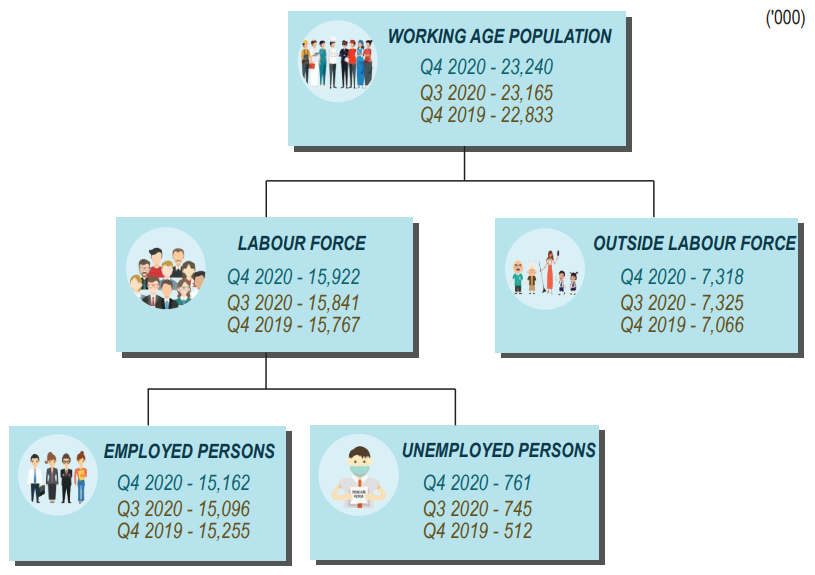
Male LFPR increased by 0.2 percentage points to 80.7 per cent. Overall, male LFPR remained consistently higher than female for all age groups. The age group that recorded the highest male LFPR was 35 to 44 years (97.7%) followed by 25 to 34 years (95.7%) and 45 to 54 years (92.3%).
Over the same period, female LFPR in the fourth quarter of 2020 stood at 55.3 per cent, as compared to the previous quarter (Q3 2020: 55.3%). The highest female LFPR in the labour market was for the age group of 25 to 34 years (74.1%), followed by 35 to 44 years (67.2%) and 45 to 54 years (61.7%). [Exhibit 2]
Exhibit 2: Labour Force Participation Rate by Sex and Age Group, Malaysia, SThird Quarter (Q3) 2020 & Fourth Quarter (Q4) 2020
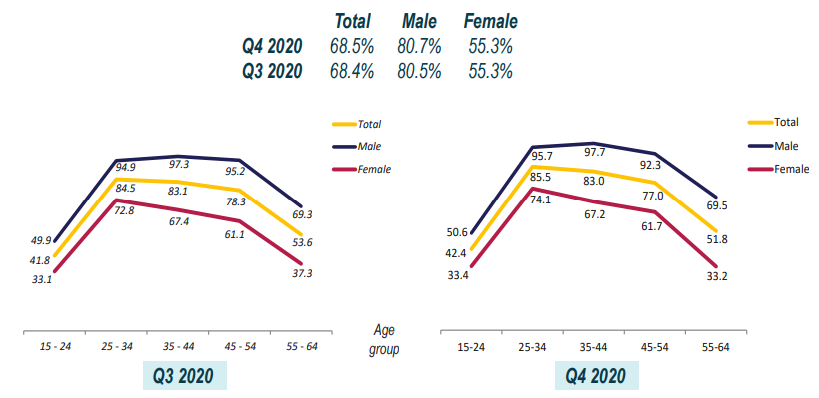
In this quarter, the employment to population ratio for male increased 0.2 percentage points to 76.9 per cent, whereas the ratio for female stayed at 52.7 per cent as compared to the third quarter of 2020. [Exhibit 3]
Exhibit 3: Main Indicator by Sex, Malaysia, Fourth Quarter (Q4) 2019, Third Quarter (Q3) 2020 & Fourth Quarter (Q4) 2020
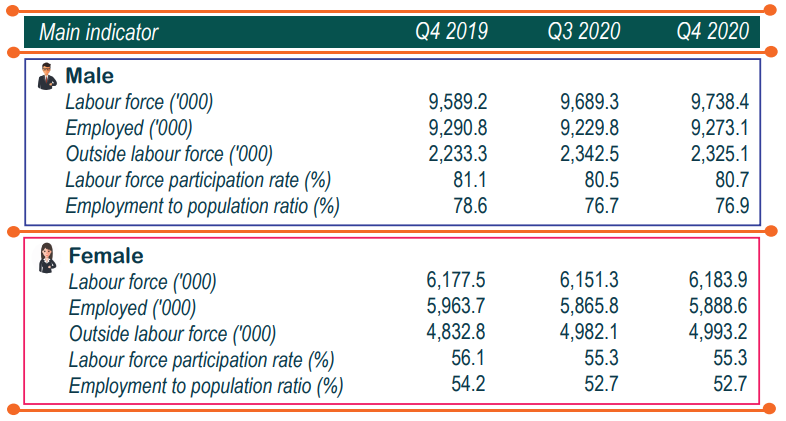
In the fourth quarter of 2020, male labour force comprised of 61.2 per cent (9.74 million persons) while female accounted for 38.8 per cent (6.18 million persons). The number of labour force for both male and female increased by 49.1 thousand persons and 32.6 thousand persons respectively as compared to the third quarter of 2020. [Exhibit 4]
Exhibit 4: Labour Force by Sex, Malaysia, Third Quarter (Q3) 2020 & Fourth Quarter (Q4) 2020
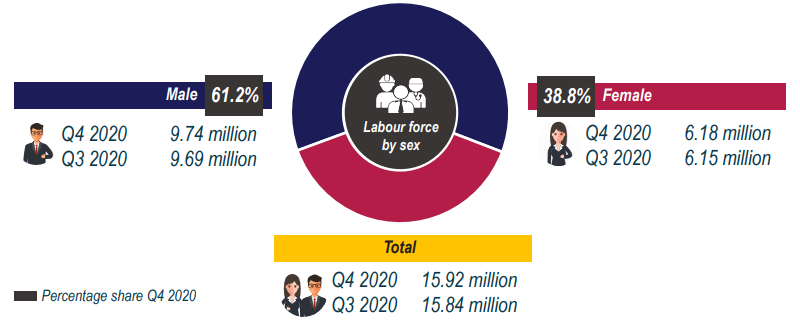
EMPLOYED PERSON
In the fourth quarter of 2020, there were 9.27 million male employed persons, which was equivalent to 61.2% of total employed persons. Whereas female comprised of 38.8 per cent of total employed persons with 5.89 million persons. Majority of the employed persons were aged between 25 to 44 (58.9%), whereas youth aged 15 to 24 contributed 14.9 per cent to the total employed persons.
By education attainment, most of them were those attained secondary education. This group of employed person comprised of 8.19 million persons with a share of 54.1 per cent. The share was dropped 0.5 percentage points as compared to the previous quarter (Q3 2020: 55.4%, 8.37 million persons). On the contrary, share of employed persons with tertiary education rose by 1.6 percentage points to 33.3 per cent recorded 5.05 million persons (Q3 2020: 31.7%, 4.79 million persons).[Exhibit 5]
Exhibit 5: Employed Person by Educational Attainment, Malaysia, Fourth Quarter (Q4) 2019, Third Quarter (Q3) 2020 & Fourth Quarter (Q4) 2020
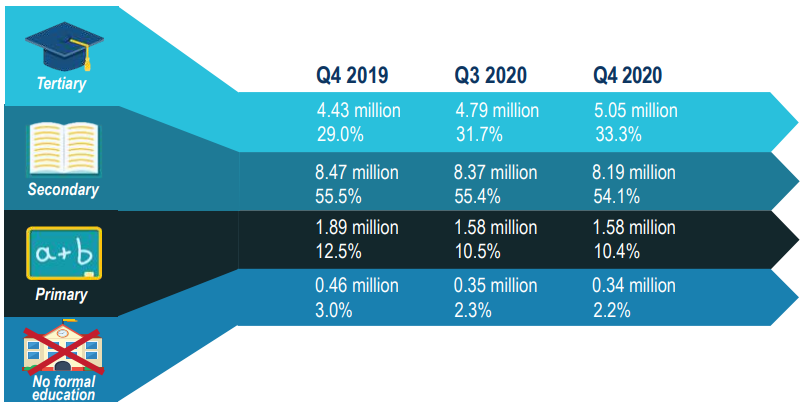
During the pandemic, those who were self-employed were affected the most. The percentage share of own-account worker fell by 0.7 percentage points to record 2.44 million persons (Q3 2020: 2.53 million persons). As for employee category which comprised of 11.70 million persons, the percentage share increased 0.8 percentage points to 77.2 per cent as compared to the previous quarter (Q3 2020: 11.53 million persons; 76.4%). [Exhibit 6]
Exhibit 6: Employed Persons by Employment Status, Malaysia, Third Quarter (Q3) 2020 & Fourth Quarter (Q4) 2020

The semi-skilled workers dominated with a share of 58.4 per cent, followed by skilled workers (30.1%). Meanwhile, low-skilled workers accounted for 11.5 per cent in the fourth quarter of 2020. The composition of low-skilled workers decreased by 0.9 percentage points from 12.4 per cent in the third quarter of 2020.
The number of skilled workers increased by 168.8 thousand person to 4.56 million persons as compared to 4.39 million persons in the third quarter of 2020. [Exhibit 7]
Exhibit 7: Employed Persons by Skill Level, Malaysia, Third Quarter (Q3) 2020 & Fourth Quarter (Q4) 2020
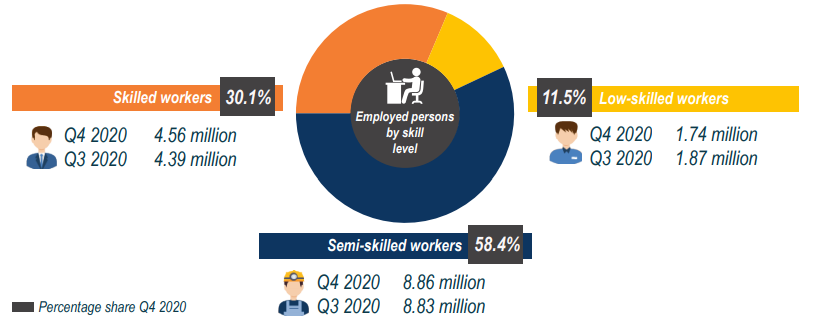
UNDEREMPLOYMENT
Working less than 30 hours per week, time-related underemployment and skill-related underemployment
A comprehensive understanding of the labour market requires analysing additional indicators alongside the unemployment rate1 . Thus, the indicators time-related underemployment and skill-related underemployment may be able to provide more insight on the Malaysia’s labour supply situation in line with the current circumstances.
Employed person working less than 30 hours per week refers to those who worked less than 30 hours during the reference week because of the nature of their work or due to insufficient work. In the fourth quarter of 2020, the number of employed persons who were working less than 30 hours per week increased 129.9 thousand persons to record 533.7 thousand persons (Q3 2020: 403.8 thousand persons). In line with this, the percentage share of those working less than 30 hours per week to the total employed persons increased to 3.5 per cent in this quarter (Q3 2020: 2.7%).
As observed for the time series of Q1 2019 to Q4 2020, the percentage share of those working less than 30 hours per week to the total employed persons was within the range of 2.0 per cent to 2.5 per cent during the year of 2019. However, the share increased began in the first quarter of 2020 at 4.4 per cent and continued to increase at a high rate of 5.3 per cent in the second quarter of 2020 due to the adversely impact of the MCO in the mid of March 2020.[Exhibit 8]
Exhibit 8: Employed person working less than 30 hours per week, Malaysia, First Quarter (Q1) 2019 – Fourth Quarter (Q4) 2020
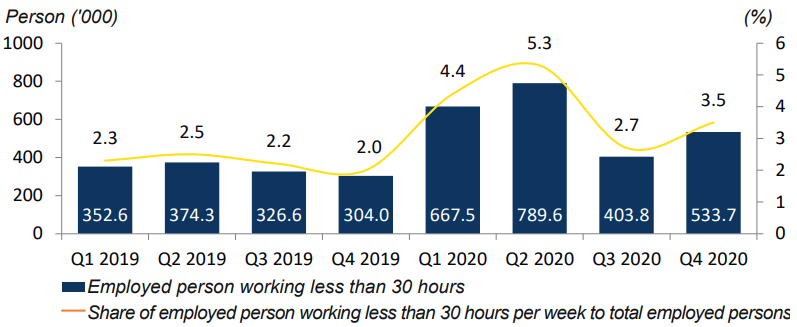
Time-related underemployment which refer to a group of people who employed less than 30 hours per week during the reference week due to the nature of their work or because of insufficient work and were able and willing to accept additional hours of work.
During the fourth quarter of 2020, time-related underemployment increased to 369.1 thousand persons from 300.8 thousand persons recorded in third quarter of 2020. Out of the total employed person, time-related underemployment encompassed 2.4 per cent, went up by 0.4 percentage points as against previous quarter (Q3 2020: 2.0%). This was due to the reopening of more businesses with longer operation hours following the implementation of various phases of MCO during the quarter.[Exhibit 9]
Exhibit 9: Time-related underemployment, Malaysia, First Quarter (Q1) 2019 – Fourth Quarter (Q4) 2020

Meanwhile, through Labour Force Survey, skill-related underemployment was measured based on those with tertiary education while working in the semi-skilled and low-skilled category. In the fourth quarter of 2020, skill-related underemployment increased further to 37.4 per cent after recording an increase since first quarter of 2019.[Exhibit 10]
Exhibit 10: Skill-related underemployment, Malaysia, First Quarter (Q1) 2019 – Fourth Quarter (Q4) 2020
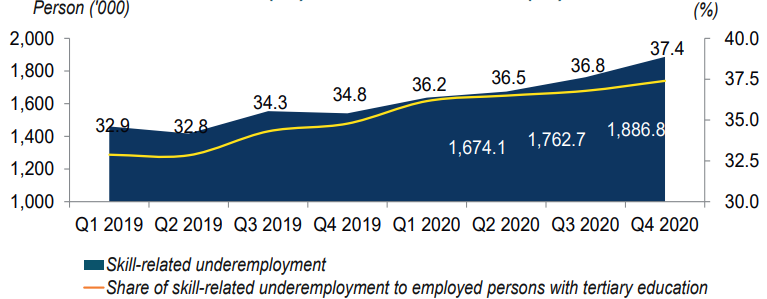
OUTSIDE LABOUR FARCE
The population of outside labour force accounted for 7.32 million persons in the fourth quarter of 2020. The main reasons of not seeking for work among the population of outside labour force was schooling (42.5%) and housework/family responsibilities (42.4%). Both groups have the potential to join the labour market if they are interested in working.[Exhibit 11]
Exhibit 11: Population Outside Labour Force by Reasons for Not Seeking Work, Malaysia, Third Quarter (Q3) 2020 & Fourth Quarter (Q4) 2020
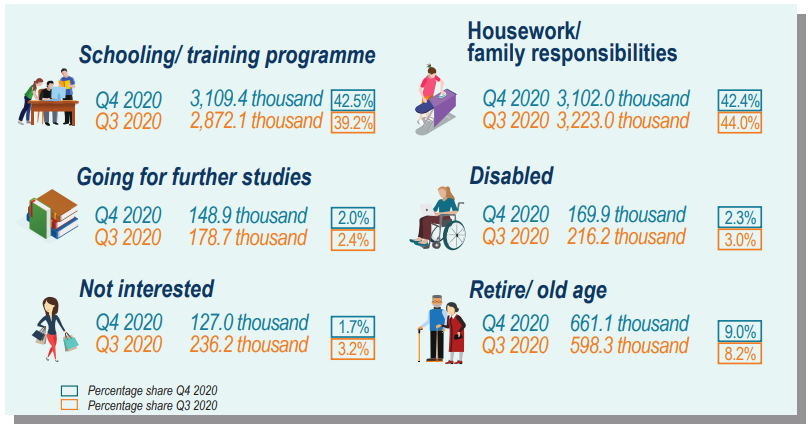
The detailed information and technical notes are published in the Labour Force Survey Report, Malaysia, Second Quarter 2019. This report is accessible and downloadable free of charge through the eStatistik application in DOSM web page, www.dosm.gov.my.
Released By:
DATO' SRI DR. MOHD UZIR MAHIDIN
CHIEF STATISTICIAN MALAYSIA
DEPARTMENT OF STATISTICS, MALAYSIA
8 February 2021
Contact person:
Mohd Yusrizal bin Ab. Razak
Public Relation Officer
Strategic Communication and International Division
Department of Statistics, Malaysia
Tel : +603-8885 7942
Fax : +603-8888 9248
Email : yusrizal.razak@dosm.gov.my
Subscribe
Newsletter
Subscribe to our newsletter and stay updated
For interviews, press statement and clarification to the media, contact:
Baharudin Mohamad
Public Relation Officer
Email: baharudin[at]dosm.gov.my
Phone: 03 8090 4681
Not found what you looking for? Request data from us, through
Go to eStatistik
Email: data[at]dosm.gov.my
Phone: 03 8885 7128 (data request)











